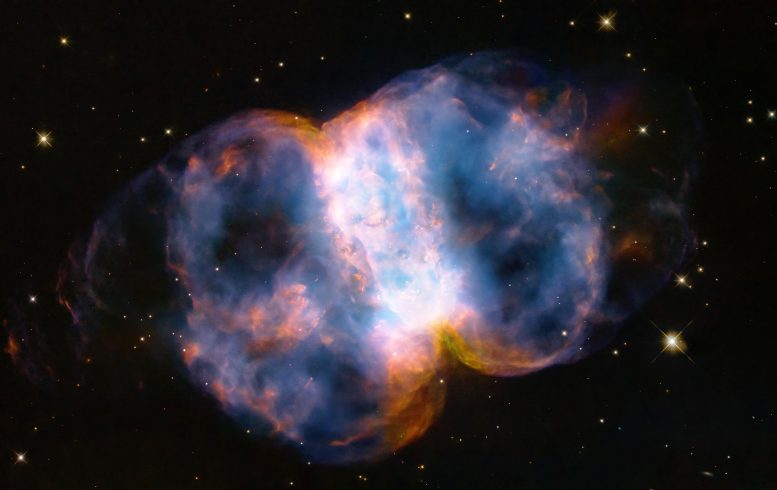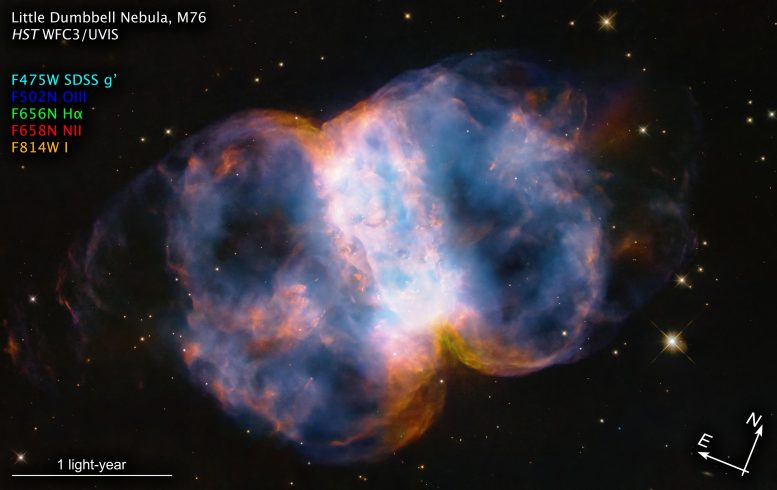
Astronomers celebrated the Hubble Space Telescope's 34th anniversary by capturing an image of the Little Dumbbell Nebula 3,400 light-years away. Hubble has conducted 1.6 million observations and contributed to more than 44,000 scientific papers. Its discoveries by the James Webb Space Telescope are expanding our understanding of the universe. Credit: NASA, ESA, STScI, A. Pagan (STScI)
A luminous bipolar bubble from a dying star expands into space
To celebrate the 34th anniversary of its launch NASAThe legend of Hubble Space Telescope On April 24, 1990, astronomers took a snapshot of the Little Dumbbell Nebula. Also known as Messier 76, M76, or NGC 650/651, it consists of a ring, with a central bar system at the edge and two lobes at either opening of the ring.
Before a red giant star burns out, it ejects a ring of gas and dust. This ring may have been carved by the effects of a binary companion star. This sluggish material formed a dense disk of dust and gas in the companion's orbital plane. The hypothesized companion star was not seen in the Hubble image, so it may have been swallowed by the central star later. The disc would be forensic evidence of that interstellar cannibalism.
The photogenic nebula is a favorite target of amateur astronomers. Professional astronomers first took a spectrum in 1891, indicating that it was a nebula rather than a galaxy or star cluster. They suggested that M76 may be similar to the donut-shaped Ring Nebula (M57).
For more than three decades, the NASA/ESA Hubble Space Telescope has revolutionized modern astronomy, taking not only astronomers but the public on an exciting journey of exploration and discovery. Each year Hubble dedicates a small portion of its precious observing time to taking a special anniversary image, showcasing particularly beautiful and meaningful objects. Hubble celebrates 34th launch anniversary with snapshot of Little Dumbbell Nebula Credit: NASA, ESA, STScI, A. Pagan (STScI), N. Bartmann (ESA/Hubble)
Hubble Celebrates 34th Anniversary of Seeing the Little Dumbbell Nebula
To celebrate the 34th anniversary of the April 24 launch of the famed NASA/ESA Hubble Space Telescope, astronomers took a 3400-light image of the Little Dumbbell Nebula (also known as Messier 76, M76, or NGC 650/651). Several years away is the northern circumpolar constellation Perseus. The photogenic nebula is a favorite target of amateur astronomers.
M76 is classified as a planetary nebula, an expanding shell of glowing gas ejected from a dying red giant star. The star eventually collapses to become more dense and hotter White Dwarf. A planetary nebula is unrelated to planets, but got its name because astronomers using low-powered telescopes in the 1700s thought this type of object resembled a planet.
The M76 is composed of a ring, with a central bar system on the rim, and two lobes at either opening of the ring. Before the star burns out, it ejects a ring of gas and dust. The ring may have been carved by the effects of a star that once contained a binary companion star. This sluggish material formed a dense disk of dust and gas in the companion's orbital plane. The hypothesized companion star was not seen in the Hubble image, so it may have been swallowed by the central star later. The disc would be forensic evidence of that interstellar cannibalism.

On its 34th anniversary, the Hubble telescope captured the Little Dumbbell Nebula, demonstrating its continuing role in cosmic discovery and astronomical research. Credit: NASA, ESA, STScI, A. Pagan (STScI)
The progenitor star collapses to form a white dwarf. It is one of the hottest stellar remnants known at 120,000 degrees Celsius. Celsius, 24 times the surface temperature of our Sun. A sizzling white dwarf can be seen as a dot in the center of the nebula. A star visible in the projection beneath it is not part of the nebula.
As it pinches off the disc, two hot gases escape from the top and bottom of the 'belt' along the star's rotation axis, which is perpendicular to the disc. They are propelled by the tornado-like material ejected from a dying star, tearing through space at two million miles per hour. This is the speed of traveling from the Earth to the Moon in seven minutes! This 'stellar wind' plows into the cold, slow-moving gas that was ejected at an earlier stage in the star's life, when it was a red giant. Intense ultraviolet radiation from a super-hot star lights up the gases. Red color is from nitrogen and blue is from oxygen.
Since our solar system is 4.6 billion years old, the entire nebula is a pan in the pan by cosmological timekeeping. It will become extinct in 15,000 years.
Scientific publication that breaks Hubble's record
Hubble has made 1.6 million observations of more than 53,000 astronomical objects since its launch in 1990. To date, the Mikulski Archive for Space Telescopes The Space Telescope Science Institute in Baltimore, Maryland has 184 terabytes of processed data ready for science to be used by astronomers around the world for research and analysis. The European Mirror of Public Data is hosted at ESA's European Space Astronomy Center (ESAC). European Hubble Space Telescope (eHST) Science Archive.
Since 1990, over 44,000 scientific papers have been published from Hubble observations. It included 1056 papers published in 2023, of which 409 were led by authors from ESA Member States. The demand for using Hubble is so high that it is currently six times over.
Throughout the past year of scientific activity, new discoveries made using Hubble include the detection of water in the thin atmosphere. extraterrestrial To date, it has discovered a strange cosmic explosion far away from any host galaxy and followed the spokes in Saturn's rings to find the unexpected home of the most distant and powerful fast radio burst ever seen. Hubble's studies of the asteroid Dimorphos, an intentional NASA spacecraft collision target in September 2022, continued to detect rocks released by the impact to alter its trajectory.
This video takes viewers to the 34th anniversary image of the famous NASA/ESA Hubble Space Telescope: the Little Dumbbell Nebula (also known as Messier 76, M76 or NGC 650/651). This object is located 3400 light-years away in the northern circumpolar constellation Perseus. The photogenic nebula is a favorite target of amateur astronomers. Credit: NASA, ESA, STScI, A. Pagan (STScI), Credit: D. Crowson, A. Fujii, Digitized Sky Survey
Hubble continues to provide spectacular images of celestial targets, including spiral galaxies, globular clusters and star-forming nebulae. A newly formed star Cosmic light show. The Hubble images were combined with infrared observations from the NASA/ESA/CSA James Webb Space Telescope to create one of the most detailed views of the universe, the galaxy cluster MACS 0416.
Many of Hubble's discoveries were not anticipated prior to launch, such as supermassive black holes, the atmospheres of exoplanets, gravitational lensing by dark matter, the existence of dark energy, and the formation of numerous interstellar planets. Hubble will continue research in those domains, as well as use its unique ultraviolet-light capability to study solar system phenomena, supernova explosions, the composition of exoplanet atmospheres, and the dynamic emission from galaxies. And Hubble probes continue to benefit from long baseline observations of Solar System objects, variable star events, and other exotic astrophysics of the Universe.
The performance characteristics of the James Webb Space Telescope are designed to be a unique complement to Hubble, not a substitute. Future Hubble research will also take advantage of the opportunity for integration with the WEB, which observes the universe in infrared light. Together, the two space telescopes' complementary wavelength coverage expands on groundbreaking research in fields such as protostellar disks, exoplanet composition, unusual supernovae, interstellar cores, and the chemistry of the distant universe.
The Hubble Space Telescope has been operating for more than three decades and continues to make new discoveries that shape our fundamental understanding of the universe.
Hubble is a project of international collaboration between NASA and ESA (European Space Agency) NASA's Goddard Space Flight Center in Greenbelt, Maryland manages the telescope and mission operations. Lockheed Martin Space in Denver, Colorado supports mission operations at Goddard. The Space Telescope Science Institute in Baltimore, Maryland, operated by the Association of Universities for Astronomical Research, runs the Hubble science operations for NASA.